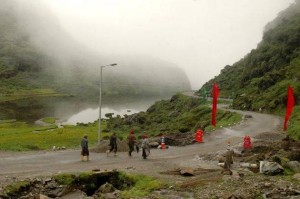
China’s President Xi Jinping made a rare gesture toward the new Modi government by making a private meeting in Beijing with India’s Foreign Minister, Sushma Swaraj. In my experience in China with a variety of Chinese from all levels, Chinese place great store on proper procedure. Normal procedure would be for Xi to meet only with Modi as head of India’s government, not with a mere minister. Rather China’s foreign minister should be the proper speaking counterparty. Xi’s decision to meet Swaraj underscores the growing effort of Beijing to develop deeper cooperative ties with her historic rival in the Indian sub-continent. During and after the Cold War, China’s main ally in that region has been not India but Pakistan, India’s bitter foe.
Now, since Modi embraced the creation of the new BRICS infrastructure development bank of Brazil, Russia, India, China and South Africa, and with the escalating US military pressures of Obama’s ill-conceived “Asia Pivot,” China is looking to firm closer ties to Modi’s India.
Xi told the Indian minister that he wanted China and India to grasp the “opportunity of the century” to combine their development strategies, and push ahead with their strategic cooperation on railways and industrial parks to benefit the 2.5 billion people of the two countries as well as the global economic development. India is considering joining Beijing’s vast New Silk Road. Xi arranged a special visit for the Indian Foreign Minister to Kunming in China’s south near the Laos border. Kunming is the starting point for China’s New Silk Road high-speed rail project.
Closer ties
The Indian minister’s discussion with President XI was part of preparation for a state visit to China by Modi following the visit of Xi to New Delhi last September. Modi, who took office only in May, 2014, has already had three personal meetings with China’s Xi. In a personal gesture of the high priority China now attaches to cementing strong Indian relations, Xi will invite Modi to Xi’s hometown in Shaanxi province.
Foreign Minister Sushma Swaraj was in Beijing for the third annual meeting of foreign ministers of Russia, China and India. At that meeting, the three countries of the BRICS issued a joint communique which among other points, “agreed that Russia, India and China should enhance their cooperation in think-tanks, business, agriculture, disaster mitigation and relief, medical services and public health. The Ministers explored potential for cooperation in oil and natural gas production and transportation, as well as in other fields of energy, high tech, environmental protection and connectivity.” They also declared that the three nations were “determined to build a more just, fair and stable international political and economic order in accordance with the purposes and principles of the UN Charter, the Five Principles of Peaceful Co-Existence and other basic norms of international law,” a clear reference to the lawless disregard of Washington for the UN Charter in either Syria or Ukraine.
Washington gets nervous
On top of the very successful visit of Russian President Putin to India in December where the two signed economic deals worth some $100 billion, what is emerging is a stark contrast to the Washington-influenced regime of Modi’s predecessor, Manmohan Singh who signed an agreement with the Bush Administration for military and security cooperation with Washington, a move aimed at giving the Pentagon an ally in Asia against China. Washington is clearly getting nervous.
Susan Rice, Obama’s bellicose Security Adviser announced on February 6 that President Obama has invited Chinese President Xi Jinping for a state visit this year. In contrast to his visits to India and his meetings with Putin, Xi’s last visit to the US was in June, 2013. Xi’s first foreign trip as new President was to Moscow to meet Putin.
Rice’s comment as to the aim of the Obama invitation to Xi spoke volumes about the fundamental divide between the two countries today. She said, “With China, we’re building a constructive relationship that expands practical cooperation across a wide spectrum of issues from global health to non-proliferation, even as we confront real differences over human rights, cyber-enabled economic espionage, and the use of coercion to advance territorial claims.” The Chinese government daily, China Daily wrote articles last year identifying the role of the US government in creating the Hong Kong “Umbrella Revolution.” Xi is not impressed when Washington chides China on “human rights.”
A decisive turn for China India relations will come in this summer at the annual meeting of the China-Russia-dominated Shanghai Cooperation Organization. India has long expressed interest in joining but hostilities and mistrust during the previous Singh government led Beijing to reject the idea. It will be interesting to see what Obama has to offer Xi beyond military encirclement and lectures on global warming.
F. William Engdahl is strategic risk consultant and lecturer, he holds a degree in politics from Princeton University and is a best-selling author on oil and geopolitics, exclusively for the online magazine “New Eastern Outlook”.
